What is PRTN3 Protein
PRTN3, also known as Proteinase 3, stands as a pivotal member of the serine protease family. Its official full name, Proteinase 3, and synonyms like PR3 encapsulate its essence. This protein, classified under the serine protease category, showcases distinctive structural characteristics that set it apart. Recent research advances have delved into the nuanced functions and implications of PRTN3, shedding light on its multifaceted roles.
PRTN3 Biological Functions and Molecular Mechanisms
The biological functions of PRTN3 are as diverse as they are intriguing. As a serine protease, PRTN3 is primarily involved in proteolytic activities, influencing key molecular processes. One of its prominent functions is linked to the immune system, where it participates in the regulation of inflammatory responses. PRTN3 plays a crucial role in the activation of neutrophils, contributing to the body's defense mechanisms against pathogens. Additionally, it modulates the immune response by interacting with various cellular components, showcasing its intricate molecular dance.
At the molecular level, PRTN3 engages in intricate interactions with its substrates, orchestrating precise cleavage events. Through its serine protease activity, PRTN3 cleaves specific protein targets, thereby influencing downstream signaling pathways. This molecular ballet extends beyond the immune system, affecting cellular processes with far-reaching consequences. Understanding the nuances of PRTN3's molecular mechanisms provides a foundation for deciphering its broader impact on cellular physiology.

Figure 1. Factors involved in PR3-ANCA pathogenicity. (Granel J R M, et al., 2021)
PRTN3 Related Signaling Pathway
The signal pathway associated with PRTN3 unfolds a complex molecular dialogue. PRTN3's involvement in immune regulation manifests through its interaction with various signaling pathways. Notably, it influences the activation of neutrophils, a critical component of the immune response. The cascade of events triggered by PRTN3 underscores its role as a molecular orchestrator in the intricate web of cellular communication.
PRTN3 Related Diseases
While PRTN3 plays a pivotal role in immune regulation, its dysregulation can lead to pathological conditions. PRTN3 is implicated in autoimmune diseases, where the immune system mistakenly targets the body's tissues. Conditions such as granulomatosis with polyangiitis (GPA) and microscopic polyangiitis (MPA) have been associated with aberrant PRTN3 activity. In these diseases, the immune system's attack on blood vessels can result in severe organ damage, emphasizing the intricate balance that PRTN3 maintains in health and disease.
PRTN3's Applications in Biomedicine
Beyond its physiological roles, PRTN3 has garnered attention in biomedical research, showcasing its potential applications in diagnostics, vaccine development, and therapeutics.
- Diagnostic Development: PRTN3's presence in autoimmune diseases makes it a potential diagnostic marker. Detection of elevated PRTN3 levels in patient samples could serve as an indicator of autoimmune conditions, aiding in early diagnosis and intervention.
- Vaccine Development: Understanding PRTN3's role in immune modulation opens avenues for vaccine development. Targeting PRTN3 in vaccine formulations could potentially modulate immune responses, offering new strategies for vaccine design.
- Therapeutics: Given its involvement in autoimmune diseases, PRTN3 becomes a target for therapeutic interventions. Inhibiting PRTN3 activity could be explored as a strategy to mitigate the severity of autoimmune conditions, presenting a novel approach in the realm of therapeutics.
Recommended Products
| Cat.# | Product name | Species | Source (Host) | Tag |
|---|---|---|---|---|
| PRTN3-1996H | Recombinant Human PRTN3 Protein, His-tagged | Human | E.coli | His |
| PRTN3-45H | Recombinant Human PRTN3 protein, His-tagged | Human | HEK293 | His |
| PRTN3-301563H | Recombinant Human PRTN3 protein, GST-tagged | Human | E.coli | GST |
| PRTN3-3376H | Recombinant Human PRTN3 protein, His&Myc-tagged | Human | E.coli | His&Myc |
| PRTN3-0257H | Recombinant Human PRTN3 protein, His-tagged | Human | HEK293 | His |
| PRTN3-406HF | Recombinant Full Length Human PRTN3 Protein | Human | In Vitro Cell Free System | |
| PRTN3-243H | Native Human PRTN3 Protein | Human | Neutrophils | |
| PRTN3-1779H | Recombinant Human PRTN3 Protein, His (Fc)-Avi-tagged | Human | HEK293 | His (Fc)-Avi |
| PRTN3-252H | Recombinant Human PRTN3 Protein, MYC/DDK-tagged, C13 and N15-labeled | Human | HEK293 | C-Myc/DDK |
| PRTN3-1556HFL | Recombinant Full Length Human PRTN3 Protein, C-Flag-tagged | Human | Mammalian cells | Flag |
Reference
- Granel J R M, et al. Pathogenicity of proteinase 3-Anti-Neutrophil cytoplasmic antibody in granulomatosis with polyangiitis: implications as biomarker and future therapies. Frontiers in Immunology. 2021, 12: 571933.

